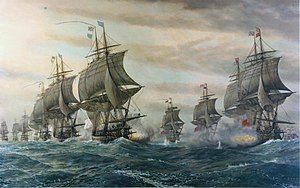
Back معركة تشيزبيك Arabic Çesapik döyüşü Azerbaijani چساپیک دؤیوشو AZB Batalla de Chesapeake Catalan Slaget ved Chesapeake Danish Seeschlacht vor der Chesapeake Bay German Batalo de Chesapeake Esperanto Batalla de la Bahía de Chesapeake Spanish نبرد چساپیک Persian Bataille de la baie de Chesapeake French
| Battle of the Chesapeake | |||||||
|---|---|---|---|---|---|---|---|
| Part of the American War of Independence and Siege of Yorktown (1781) | |||||||
 The French line (left) and British line (right) do battle | |||||||
| |||||||
| Belligerents | |||||||
|
|
| ||||||
| Commanders and leaders | |||||||
|
|
| ||||||
| Strength | |||||||
| 24 ships of the line with 1,542 guns[2] | 19 ships of the line with 1,410 guns[3] | ||||||
| Casualties and losses | |||||||
|
220 killed or wounded 2 ships damaged[4] |
90 killed 246 wounded 5 ships damaged 1 ship scuttled[4][5] | ||||||
The Battle of the Chesapeake, also known as the Battle of the Virginia Capes or simply the Battle of the Capes, was a crucial naval battle in the American Revolutionary War that took place near the mouth of the Chesapeake Bay on 5 September 1781. The combatants were a British fleet led by Rear Admiral Sir Thomas Graves and a French fleet led by Rear Admiral François Joseph Paul, the Comte de Grasse. The battle was strategically decisive,[1] in that it prevented the Royal Navy from reinforcing or evacuating the besieged forces of Lieutenant General Lord Cornwallis at Yorktown, Virginia. The French were able to achieve control of the sea lanes against the British and provided the Franco-American army with siege artillery and French reinforcements. These proved decisive in the Siege of Yorktown, effectively securing independence for the Thirteen Colonies.
Admiral de Grasse had the option to attack British forces in either New York or Virginia; he opted for Virginia, arriving at the Chesapeake at the end of August. Admiral Graves learned that de Grasse had sailed from the West Indies for North America and that French Admiral de Barras had also sailed from Newport, Rhode Island. He concluded that they were going to join forces at the Chesapeake. He sailed south from Sandy Hook, New Jersey, outside New York Harbor, with 19 ships of the line and arrived at the mouth of the Chesapeake early on 5 September to see de Grasse's fleet already at anchor in the bay. De Grasse hastily prepared most of his fleet for battle—24 ships of the line—and sailed out to meet him. The two-hour engagement took place after hours of maneuvering. The lines of the two fleets did not completely meet; only the forward and center sections fully engaged. The battle was consequently fairly evenly matched, although the British suffered more casualties and ship damage, and it broke off when the sun set. The British tactics have been a subject of debate ever since.
The two fleets sailed within view of each other for several days, but de Grasse preferred to lure the British away from the bay where de Barras was expected to arrive carrying vital siege equipment. He broke away from the British on 13 September and returned to the Chesapeake, where de Barras had since arrived. Graves returned to New York to organize a larger relief effort; this did not sail until 19 October, two days after Cornwallis surrendered.
[The] Battle of the Chesapeake was a tactical victory for the French by no clearcut margin, but it was a strategic victory for the French and Americans that sealed the principal outcome of the war.
© MMXXIII Rich X Search. We shall prevail. All rights reserved. Rich X Search